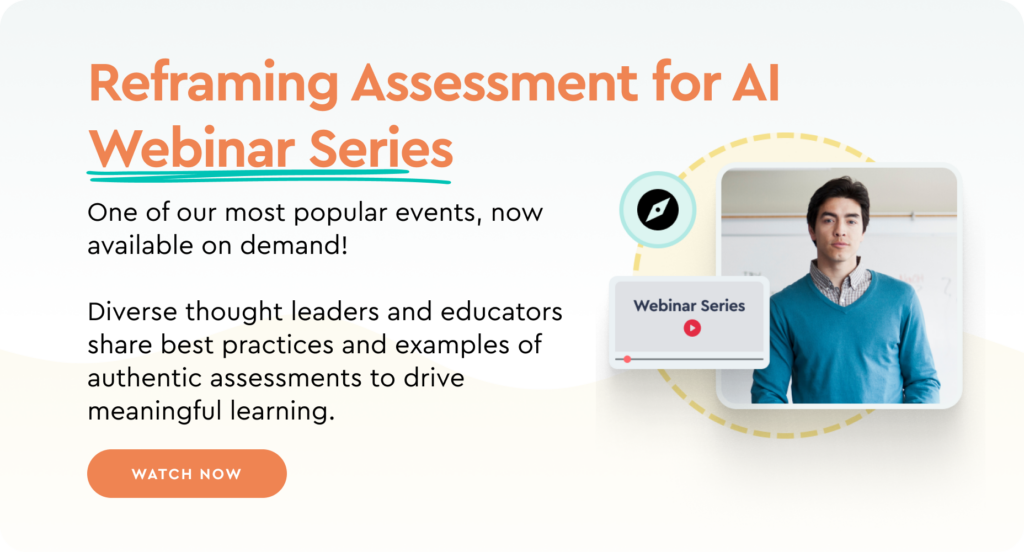Authentic assessment has emerged as a powerful tool in education, allowing students to showcase their skills and competencies while focusing on real-world applications. Unlike traditional assessments that primarily gauge rote knowledge, authentic assessments are designed to assess what students can do.
To achieve meaningful learning through authentic assessment, feedback plays a pivotal role in guiding students towards improvement and fostering a deeper understanding of their strengths and weaknesses. In this blog, we explore the best practices for authentic assessments, the different types of feedback that support authentic assessment, and how video can enhance the feedback process for stronger authentic assessments overall.
Authentic Assessment Best Practices
Educators’ primary goal is to ensure that our students are not only knowledgeable in their field but also equipped with critical skills such as communication, critical thinking, and problem-solving. Authentic assessments bridge the gap between theoretical knowledge and real-world application, providing students with the opportunity to demonstrate their competence in a meaningful context. To develop successful authentic assessments, here are some best practices to follow:
Focus on skills and competencies
Authentic assessments should prioritize the evaluation of practical skills and competencies that are relevant to students’ future careers and daily life. This shift from mere knowledge acquisition to skill development ensures students are prepared for the real world.
Understand what students can do
Instead of measuring what students know, authentic assessments should gauge their abilities and what they can accomplish in real-world situations. This approach emphasizes application over memorization.
Develop Relevant Skills for Work and Life
Authentic assessments should align with the skills and knowledge students will actually need in their careers and daily lives. This makes learning more meaningful and applicable.

The Role of Feedback in Facilitating Authentic Assessments
Feedback is an essential component of authentic assessments as it guides students towards improvement, provides clarity on their performance, and fosters self-reflection. It helps bridge the gap between current abilities and desired outcomes. Let’s explore different types of feedback that are vital for the success of authentic assessments:
Oral Feedback
Verbal feedback, provided by instructors or peers, allows for immediate interaction and clarification. It offers a personal touch and can help address specific questions and concerns.
Written Feedback
Feedback that’s written or typed is valuable for its clarity and permanence. Instructors can provide detailed comments on assignments, enabling students to revisit and reflect on their work.
Peer Feedback
Feedback from peers allows students to learn from one another. It encourages a collaborative learning environment and often provides fresh perspectives and insights.

Self-Assessed Feedback
Self-assessment empowers students to evaluate their own work. It promotes self-reflection and helps students take ownership of their learning journey.
Instructor Feedback
Feedback from educators and instructors is vital for its expertise and experience. Instructors can provide valuable insights, guidance, and suggestions for improvement.
How Video Supports Different Types of Feedback
Video is an incredibly versatile tool that supports and enhances the various types of feedback in authentic assessments. Here are 5 ways video can facilitate more meaningful feedback:
1. Videos provide evidence of skill building
Video recordings offer concrete evidence of a student’s performance. This visual documentation is valuable for both students and assessors to evaluate skills and competencies.
Hear from education leader Brian Arnold of National University on how critical video evidence is for preparing work-ready students.

2. Videos drive self-improvement and lifelong learning
Video assessments allow students to provide feedback on their own work, fostering self-awareness and improvement. This practice is directly applicable to their future jobs where feedback is integral for growth.
3. Videos allow for multiple reviewers
Video can be reviewed by peers, instructors, or experts, enabling a holistic evaluation from multiple perspectives. This ensures well-rounded feedback and a comprehensive understanding of performance.
4. Videos enable personalized and precise feedback
Video feedback can be highly specific, pinpointing strengths and areas for improvement. Instructors and peers can offer detailed commentary, helping students make meaningful changes.
5. Videos offer a historical record of skill development
A library of video assessments can be used to track a student’s progress over time. It showcases how skills have developed, providing insights into the journey of improvement.
How GoReact Enhances Authentic Assessments
If you’re looking for a robust solution that combines video and feedback to support all types of authentic assessment, consider GoReact. This tool empowers educators to provide meaningful feedback through video, enhancing the learning experience and fostering skill development. With GoReact, you can take your authentic assessments to the next level, helping students become better prepared for their future careers.
Ready to learn more?
Access our Ultimate Guide to Authentic Assessment in an AI-Enabled World for insights and practical tips on designing assessments to support learning and prevent cheating in the age of AI.









